Why Measuring Air Speed at Bird Level May Not Be Advisable
Published: October 14, 2016
By: Michael Czarick 1 and Brian Fairchild 2. / The University of Georgia, College of Agricultural and Environmental Sciences, Cooperative Extension. 1 Extension Engineer; 2 Extension Poultry Scientist.

Figure 1. Air speeds in fifteen locations across the cross-section of a 40' X 500' broiler house with market-age birds.
Keeping market-age birds cool during hot weather is all about air speed. It’s quite simple. The greater the air speed in a house, the greater the amount of heat removed from the birds, the lower their body temperature, and the better weight gains and feed conversions will be. Though evaporative cooling pads do aid in bird heat removal during hot weather by keeping house temperatures from becoming excessive, their use results in higher humidity levels which reduces a bird’s ability to cool itself by evaporating water off its respiratory system. The fact is without sufficient air speed moving over the birds, evaporative cooling pads can often do more harm than good. Because air speed is the primary tool poultry producers have at their disposal to cool their birds, it is important that air speeds are monitored closely during hot weather.
The challenge with measuring air speed in a tunnel-ventilated house is that there is a high degree of variability across the cross-section of a house. Air speeds tend to be highest in the center of the cross-section then decrease as you move towards the side walls, floor, and ceiling. The amount of variation in air speed across the cross-section is determined by factors such as wall smoothness, the use of tunnel doors and/or deflector curtains, heating system type and location, the number of tunnel fans operating, as well as the presence and size of the birds in a house. In most houses these factors will cause air speeds to vary as much as 100% across the cross-section of the house (Figure 1). This level of variation not only makes it difficult to accurately determine the average air speed in a tunnel-ventilated house, but also can make it difficult compare air speeds between houses.
Since it is essentially only the air moving over the birds that produces the cooling effect, there is often a desire to measure air speed at bird level. Though this may seem an ideal place to measure air speed, the problem is that it actually it is one of the most difficult places to accurately measure air speed in a tunnel house. Air speed measurements near the floor tend to vary more than those taken in any other area in a house, often leading to measurement errors of a 100 ft/min or more.
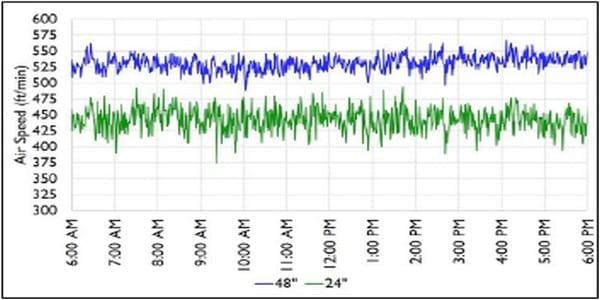
Figure 2. Air velocity in a 40' X 500' house with 8-week-old broilers 48" and 24" above the ground 10' off the side wall, 100' from the tunnel fan end wall (6 am to 6 pm).

Figure 3. Anemometer pole in a house with market-age broilers.
Figure 2 illustrates the air velocity 24" and 48" above the floor in a 40' X 500' tunnel-ventilated broiler house, approximately ten feet from the side wall and 100' from the tunnel fan end wall. The totally enclosed house had 8-week-old broilers and air speed measurements were being recorded every minute, 24 hours a day. The anemometer nearest the ground was roughly 12" above the heads of the birds when they were seated (Figure 3). During the 12-hour period shown in Figure 2, air speeds 12" above the birds were roughly 100 ft/min less than that measured 24" higher, which is fairly typical of what is seen in most tunnel-ventilated houses.
The reduction in air speed near the floor is due to the birds effectively turning the relatively smooth floor into a fairly rough surface which the air moving down the house has to flow over. Just as large side-wall posts tend to move air away from the side wall, resulting in significantly lower air speeds near the side wall, the rough surface created by market-age birds tends to push the air away from the floor and up towards the ceiling resulting in lower air speeds near the floor (Poultry Housing Tips. Vol 16 No 6. Air Speed Distribution in Tunnel-Ventilated Houses - Part 2).
Figures 4 and 5 show air speed profiles in the same 40' X 500' house without and with birds present. When the house was empty, the average air speed 24" above the floor was a little over 600 ft/min. When air speeds were measured six weeks later with market age birds present, air speed at floor level was roughly 100 ft/min lower. Air speeds at higher locations in the house increased slightly due to the air near the floor being displaced towards the ceiling by the presence of the birds.
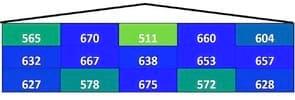 | 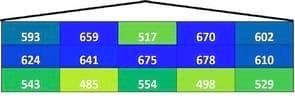 | |
| Figure 4. Air velocity profile in 40' X 500' house with all fans operating and no birds present. | Figure 5. Air velocity profile in a 40' X 500' house with all fans operating and market-age birds present. |
The effect that the birds have on air speed near the floor is more apparent when the lights are off. When the lights shut off, the birds will sit down and become inactive. The relatively motionless birds present a relatively smoother surface for the air moving down the house, resulting in a significant increase in air speeds near bird level. Figure 6 illustrates air speed and temperature in a 50' x 560' house with market-age birds and all the tunnel fans operating 24 hours a day. The house lights turn off at 9 pm and back on a 3 am. During the day when the birds are active, air velocity near the floor was approximately 600 ft/min. Starting around 6 pm, as the birds anticipated the lights turning off at 9 pm, the birds began to be less active resulting in a smoother floor surface and higher wind speeds near the floor. When all the birds were seated at 9 pm, air speed near the floor increased by nearly 100 ft/min compared to the daytime when the birds were active.
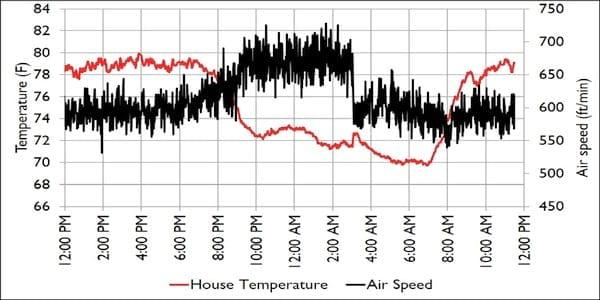
Figure 6. Air velocity 24" above the ground in a tunnel-ventilated house with all fans operating 24 hours a day (lights off 9 pm to 3 am).
The birds in a tunnel-ventilated house not only tend to reduce air speeds near floor level but they also cause significant variations in air speed near the floor. Birds continuously standing up and sitting down result in a constantly changing surface that the air flowing down the house moves over, which in turn causes air speeds near the floor to vary. For instance, in Figure 2, while air speed measurements 48" above the floor only varied between 25 and 50 ft/min, measurements 24" above the floor varied almost twice as much, 50 to 100 ft/min. Figure 6 illustrates how quickly air speed measurements can change near the floor. Measurements taken near the floor one minute can increase or decrease 50 to 100 ft/min a minute or two later making it very difficult to obtain a true representative air speed measurement near the birds (Figure 7). To complicate matters, when measurements are made the birds in the house will often move away from the measurement locations which could result in even greater variations in air speed measurements near floor level.
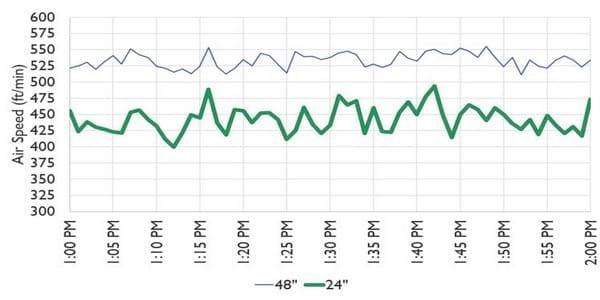
Figure 7. Air velocity in a 40' X 500' house with 8-week-old broilers 48" and 24" above the ground 10' off the side wall, 100' from the tunnel fan end wall (1 pm to 2 pm).
Though ideally it would be best to measure air speed at floor level, the highly variable nature of these measurements can easily lead to inaccurate measurements and possibly incorrect conclusions. As a result it is typically best to measure air speeds four to five feet above the floor and realize the air speed at floor level is around 100 ft/min lower when all the fans are operating. Measurements can be made at four to six locations across the width of the house and averaged. Though this does not produce a precise determination of the average air speed, it will provide at least a measurement that is repeatable and representative of the level of air movement in a tunnel-ventilated house.
This article was originally published at UGA Cooperative Extension Poultry Housing Tips Vol. 28 no. 5, 2016.
Related topics
Authors:
Join to be able to comment.
Once you join Engormix, you will be able to participate in all content and forums.
* Required information
Would you like to discuss another topic? Create a new post to engage with experts in the community.
Create a postUniversity of Hohenheim
16 de septiembre de 2019
I do not fully agree that "it is ALL about air speed". I think you should also consider the temparature underneath the litter surface. When keeping the birds at high stocking density ventilation above the birds may not be effective in removing the heat developed by microbial acitivty in the litter (see Reiter and Bessei, 2000; loc. cit Bessei W, 2006. Welfare of broilers: a review. Worlds Poultry Science Journal, 62, 455-466)
University of Georgia
31 de octubre de 2016
Ismet Mamode
Air speed can be varied by simply changing the number of fans operating. This is far less expensive and simpler than installing variable speed exhaust fans.
University of Georgia
31 de octubre de 2016
Muhammad Faeooq Qureshi
If a measurement at floor level is not accurate then in accurate conclusions will be drawn about the level of bird cooling in a house. By measuring the air speed accurately higher above the floor and realizing that air speed at bird level is around 100 ft/min lower that is better than taking a possible incorrect measurement at bird level.
University of Georgia
31 de octubre de 2016
Dr. Derbi:
Measuring air speed in a tunnel house is not a precise science. What we are trying to do by measuring air speed a few feet above the floor is to get a relative idea of what the air speed is in the house so we can make comparisons between houses. In general it takes air speed differences of at 100 ft/min or more to result in a significant differences in bird cooling and therefore performance.
16 de abril de 2017
Better if able to get more details about speed, measuring height, consequent temp. and humidity.
Regards
15 de noviembre de 2016
Mr M.Aderbi, that is a very good result you got there. Can you share with us about your air speed, humidity and temperature for different stage of production in broiler?
2 de noviembre de 2016
Greetings Mr Pirzado Zakria
These results seem to be very good. Wish you good luck. Please let me ask what is the breed? We've Ross 308..
Thanx..
2 de noviembre de 2016
Thanks Mr. M. Aderbi, for sharing valuable knowledge. In Pakistan best result in tunnel ventilation system is around 2100 g weight, feed efficiency 1.6 and mortality around 3.5% at 33-35 days.
31 de octubre de 2016
Dear Dr Mike Czarick
Nice to see your response. We have introduced the tunnel ventilation system in our brioler farms in 2004 for the first time in Saudi Arabia. I had modified the system to get adapted to our environmental and climate conditions. The system works very well and help to have excellent birds performance. The farm results of last cycle which finished 3 days ago: FCR 1.48 mortality 2.46% average weight at 28 day 1469 grams per bird. By the way our market requires small weights not like American or other markets.
My regards















.jpg&w=3840&q=75)